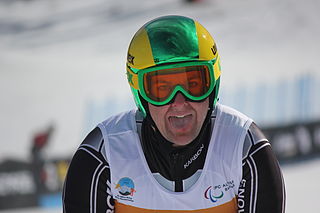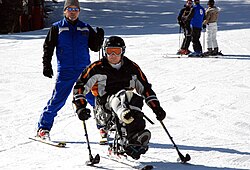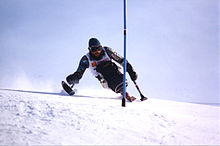
Alpine skiing at the 2002 Winter Paralympics consisted of 53 events, 34 for men and 19 for women which all took place at the Snowbasin Ski Area.

The 2011 IPC Alpine Skiing World Championships was held in Sestriere, Italy, from January 14 to 23, 2011. IPC stands for International Paralympic Committee.

The 1994 Winter Paralympics were held in Lillehammer, Norway. Australia sent six male skiers, who won three gold, two silver and four bronze medals. Australia, at the time, achieved their best ever performance at a Winter Paralympics, finishing 5th overall in the alpine skiing competition, 9th in the medal standings, and 11th in the total medal count out of 31 nations.
Para-alpine skiing classification is the classification system for para-alpine skiing designed to ensure fair competition between alpine skiers with different types of disabilities. The classifications are grouped into three general disability types: standing, blind and sitting. Classification governance is handled by International Paralympic Committee Alpine Skiing. Prior to that, several sport governing bodies dealt with classification including the International Sports Organization for the Disabled (ISOD), International Stoke Mandeville Games Federation (ISMWSF), International Blind Sports Federation (IBSA) and Cerebral Palsy International Sports and Recreation Association (CP-ISRA). Some classification systems are governed by bodies other than International Paralympic Committee Alpine Skiing, such as the Special Olympics. The sport is open to all competitors with a visual or physical disability. It is not open to people with intellectual disabilities.
LW12 is a para-alpine and para-Nordic sit skiing sport class defined by the International Paralympic Committee (IPC). An LW12 skier needs to meet a minimum of one of several conditions including a single below knee but above ankle amputation, monoplegia that exhibits similar to below knee amputation, legs of different length where there is at least a 7 centimetres difference, combined muscle strength in the lower extremities less than 71. For international competitions, classification is done through IPC Alpine Skiing or IPC Nordic Skiing. For sub-international competitions, classification is done by a national federation such as Alpine Canada. For para-alpine, this class is subdivided into two subclasses.: LW12.1 and LW12.2. A new sit-skier competitor with only national classification will compete as LW12.2 in international competitions until they have been internationally classified.

LW11 is a para-alpine and para-Nordic sit skiing sport class, a classification defined by the International Paralympic Committee (IPC for people with paralysis in the lower extremities and people with cerebral palsy that affects the lower half of the body. Outside of skiing, the competitor in this class is unable to walk. For international competitions, classification is done through IPC Alpine Skiing or IPC Nordic Skiing. For sub-international competitions, classification is done by a national federation such as Alpine Canada.

LW10 is a para-alpine and para-Nordic sit-skiing classification for skiers who cannot sit up without support. For international skiing competitions, classification is conducted by IPC Alpine Skiing and IPC Nordic Skiing, while national federations such as Alpine Canada handle classification for domestic competitions.

LW1 is a para-alpine standing skiing classification for people with severe lower extreme disabilities in both extremities. It includes both skiers with amputations and cerebral palsy. International classification is done through IPC Alpine Skiing, and national classification through local national sport federations. LW1 classified skiers use outriggers, and two skis or one ski with a prosthesis. Other equipment is used during training such as ski-tips, ski-bras, and short skis.

LW2 is a para-alpine and para-Nordic standing ski sport class defined by the International Paralympic Committee (IPC). Competitors in this class have severe disability in a lower limb, which may be a result of an amputation, or arthrodesis in the leg and hip. Depending on the type of skiing, the international classification process for LW2 skiers is handled by the IPC Alpine Skiing Technical Committee and IPC Nordic Skiing Technical Committee. National sport federations handle classification on the lower levels.
LW3 is a para-alpine and para-Nordic standing skiing sport class defined by the International Paralympic Committee (IPC) for skiers with a disability affecting both legs, with double below knee amputation or a combined strength total for both legs of 60, with 80 as the baseline for people without disabilities. For international skiing competitions, classification is done through IPC Alpine Skiing or IPC Nordic Skiing. The classification has two subclasses for para-alpine skiing: LW3.1 which is for people with double below the knee amputations or similar disabilities, and LW3.2 which is for people with cerebral palsy that involves moderate athetoid, moderate ataxic impairment or slight diplegic involvement.
LW4 is a para-alpine and para-Nordic standing skiing sport class defined by the International Paralympic Committee (IPC) for skiers who may have a disability in one lower extremity, which may be a result of a leg amputation below the knee, knee arthrodesis or a hip arthrodesis. For international skiing competitions, classification is done through IPC Alpine Skiing or IPC Nordic Skiing. A national federation such as Alpine Canada handles classification for domestic competitions.
LW5/7 is a standing para-alpine and para-Nordic skiing classification for skiers with upper extremity issues in both limbs that may include double amputation of both arms and hands or dysmelia of the upper limbs. The class has three subclasses defined by the location of the disability on the upper extremities. International classification is done by IPC Alpine Skiing and IPC Nordic Skiing. On the national level, classification is handled by national sports federation such as Cross-Country Canada.

LW6/8 is a para-alpine and para-Nordic standing skiing sport class, a classification defined by the International Paralympic Committee (IPC) for people with an upper extremity issue who have paralysis, motor paresis affecting one arm, a single upper arm amputation or CP8 classified cerebral palsy. LW6/8 skiers use two skis and one pole in both para-alpine and para-Nordic skiing.
LW9 is a para-alpine and para-Nordic standing skiing sport class, a classification defined by the International Paralympic Committee (IPC) for people with upper and lower limb function problems, and includes cerebral palsy skiers classified CP5, CP6 and CP7, along with people with hemiplegia or amputations. For international skiing competitions, classification is done through IPC Alpine Skiing or IPC Nordic Skiing. A national federation such as Alpine Canada handles classification for domestic competitions. This classification is separated into two subclasses including LW9.1 and LW9.2.

Melissa Perrine is a B2 classified visually impaired para-alpine skier from Australia. She has competed at the four Winter Paralympics from 2010 to 2022. At the 2015 IPC Alpine Skiing World Championships, she won three gold, one silver and one bronze medals. At the 2018 Winter Paralympics, she won two bronze medals.

Mitchell Gourley is an Australian Paralympic alpine skier who competed for Australia in the downhill, super-G, giant slalom, slalom and super combined events at four Winter Paralympics - 2010 to 2022. He was Australian team co-captain with Joany Badenhorst at the 2018 Winter Paralympics. At the 2022 Winter Paralympics, he and Melissa Perrine carried the Australian flag in the opening ceremony. At the 2017 IPC Alpine Skiing World Championships in Tarvisio, Italy he won the gold medal in the men's Super Combined Standing.

Andy Bor is an Australian former ski coach and sighted guide for visually impaired skiers. He was a coach at the 2006 Winter Paralympics in Torino, and was Melissa Perrine's guide skier at the 2010 Winter Paralympics in Vancouver and 2014 Winter Paralympics in Sochi.

The 2015 IPC Alpine Skiing World Championships was an international disability sport alpine skiing event held in Panorama Mountain Village, British Columbia, Canada from March 2 to 10, 2015. The Championship is held biannually by the International Paralympic Committee (IPC) and is the largest event of its type outside the Winter Paralympics.

The 2013 IPC Alpine Skiing World Championships was an international disability sport alpine skiing event held in La Molina ski resort in Spain from 18 to 27 February 2013. The Championship is held biannually by the International Paralympic Committee (IPC) and is the largest event of its type outside the Winter Paralympics.

















